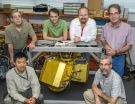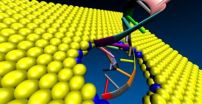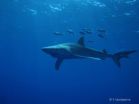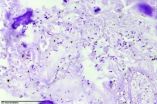UT Arlington team's work could lead to earlier diagnosis, treatment of mental diseases
Detecting neural glitches
2014-08-13
(Press-News.org) A computer science and engineering associate professor and her doctoral student graduate are using a genetic computer network inference model that eventually could predict whether a person will suffer from bipolar disorder, schizophrenia or another mental illness.
The findings are detailed in the paper "Inference of SNP-Gene Regulatory Networks by Integrating Gene Expressions and Genetic Perturbations," which was published in the June edition of Biomed Research International. The principal investigators were Jean Gao, an associate professor of computer science and engineering, and Dong-Chul Kim, who recently earned his doctorate in computer science and engineering from UT Arlington.
"We looked for the differences between our genetic computer network and the brain patterns of 130 patients from the University of Illinois," Gao said. "This work could lead to earlier diagnosis in the future and treatment for those patients suffering from bipolar disorder or schizophrenia. Early diagnosis allows doctors to provide timely treatments that may speed up aid to help affected patients."
The UT Arlington researchers teamed with Jiao Wang of the Beijing Genomics Institute at Wuhan, China; and Chunyu Liu, visiting associate professor at the University of Illinois Department of Psychiatry, on the project.
Gao said the findings also could lead to more individualized drug therapies for those patients in the early stages of mental illnesses.
"Our work will allow doctors to analyze a patient's genetic pattern and apply the appropriate levels of personalized therapy based on patient-specific data," Gao said.
One key to the research is designing single nucleotide polymorphism or SNP networks, researchers said.
"SNPs are regulators of genes," said Kim, who joins the University of Texas-Pan American this fall as an assistant professor. "Those SNPs visualize how individual genes will act. It gives us more of a complete picture."
The paper is a culmination of four years of work.
Khosrow Behbehani, dean of the College of Engineering, said the research merges the power of computer science and engineering, psychology and genetics.
"This research holds a lot of promise in the area of genetic expression," Behbehani said. "If successful, it opens up the possibility of applying the method to other pathological conditions."
INFORMATION:
About UT Arlington
The University of Texas at Arlington is a comprehensive research institution and the second largest institution in The University of Texas System. The Chronicle of Higher Education ranked UT Arlington as the seventh fastest-growing public research university in 2013. U.S. News & World Report ranks UT Arlington fifth in the nation for undergraduate diversity. Visit http://www.uta.edu to learn more. Follow #UTAdna on Twitter.
ELSE PRESS RELEASES FROM THIS DATE:
Three radars are better than one: Field campaign demonstrates two new instruments
2014-08-13
Putting three radars on a plane to measure rainfall may seem like overkill. But for the Integrated Precipitation and Hydrology Experiment field campaign in North Carolina recently, more definitely was better.
The three instruments, developed by the High Altitude Radar group at NASA's Goddard Space Flight Center in Greenbelt, Maryland, flew as part of the Global Precipitation Measurement (GPM) mission's six-week ground-validation program that took place May 1 through June 15 in the southern Appalachians, specifically to measure rain in difficult-to-forecast mountain regions. ...
New material could enhance fast and accurate DNA sequencing
2014-08-13
CHAMPAIGN, Ill. — Gene-based personalized medicine has many possibilities for diagnosis and targeted therapy, but one big bottleneck: the expensive and time-consuming DNA-sequencing process.
Now, researchers at the University of Illinois at Urbana-Champaign have found that nanopores in the material molybdenum disulfide (MoS2) could sequence DNA more accurately, quickly and inexpensively than anything yet available.
"One of the big areas in science is to sequence the human genome for under $1,000, the 'genome-at-home,'" said Narayana Aluru, a professor of mechanical ...
Patent examiners more likely to approve marginal inventions when pressed for time
2014-08-13
CHAMPAIGN, Ill. — Haste makes waste, as the old saying goes. And according to research from a University of Illinois expert in patent law, the same adage could be applied to the U.S. Patent and Trademark Office, where high-ranking examiners have a tendency to rubber-stamp patents of questionable merit due to time constraints.
The less time patent examiners are given to review an application, the more likely they are to grant patent protection to inventions "on the margin," says a study co-authored by Melissa Wasserman, the Richard and Anne Stockton Faculty Scholar and ...
Bones from nearly 50 ancient flying reptiles discovered
2014-08-13
Scientists discovered the bones of nearly 50 winged reptiles from a new species, Caiuajara dobruskii, that lived during the Cretaceous in southern Brazil, according to a study published August 13, 2014 in the open-access journal PLOS ONE by Paulo Manzig from Universidade do Contestado, Brazil, and colleagues.
The authors discovered the bones in a pterosaur bone bed in rocks from the Cretaceous period. They belonged to individuals ranging from young to adult, with wing spans ranging from 0.65-2.35m, allowing scientists to analyze how the bones fit into their clade, but ...
Embalming study 'rewrites' chapter in Egyptian history
2014-08-13
The origins of mummification may have started in ancient Egypt 1,500 years earlier than previously thought, according to a study published August 13, 2014 in the open-access journal PLOS ONE by Stephen Buckley from University of York and colleagues from Macquarie University and University of Oxford.
Previous evidence suggests that between ~4500 B.C. and 3100 B.C., Egyptian mummification consisted of bodies desiccating naturally through the action of the hot, dry desert sand. The early use of resins in artificial mummification has, until now, been limited to isolated occurrences ...
Little penguins forage together
2014-08-13
Most little penguins may search for food in groups, and even synchronize their movements during foraging trips, according to a study published August 13, 2014 in the open-access journal PLOS ONE by Maud Berlincourt and John Arnould from Deakin University in Australia.
Little penguins are the smallest penguin species and they live exclusively in southern Australia, New Zealand, and the Chatham Islands, but spend most of their lives at sea in search of food. Not much is known about group foraging behavior in seabirds due to the difficulty in observing their remote feeding ...
Young blue sharks use central North Atlantic nursery
2014-08-13
Blue sharks may use the central North Atlantic as a nursery prior to males and females moving through the ocean basin in distinctly different patterns, according to a study published August 13, 2014 in the open-access journal PLOS ONE by Frederic Vandeperre from University of the Azores, Portugal, and colleagues.
Shark populations typically organize by location and separate by sex and size, but these patterns remain poorly understood, particularly for exploited oceanic species such as the blue shark. The authors of this study employed a long-term electronic tagging experiment ...
Bacterial biosurgery shows promise for reducing the size of inoperable tumors
2014-08-13
Kansas City, MO. — Deep within most tumors lie areas that remain untouched by chemotherapy and radiation. These troublesome spots lack the blood and oxygen needed for traditional therapies to work, but provide the perfect target for a new cancer treatment using bacteria that thrive in oxygen-poor conditions. Now, researchers have shown that injections of a weakened version of one such anaerobic bacteria -- the microbe Clostridium novyi -- can shrink tumors in rats, pet dogs, and a human patient.
The findings from BioMed Valley Discoveries and a nationwide team of collaborators ...
Embalming study 'rewrites' key chapter in Egyptian history
2014-08-13
Researchers from the Universities of York, Macquarie and Oxford have discovered new evidence to suggest that the origins of mummification started in ancient Egypt 1,500 years earlier than previously thought.
The scientific findings of an 11-year study by a researcher in the Department of Archaeology at York, and York's BioArCh facility, and an Egyptologist from the Department of Ancient History at Macquarie University, push back the origins of a central and vital facet of ancient Egyptian culture by over a millennium.
Traditional theories on ancient Egyptian mummification ...
Injected bacteria shrink tumors in rats, dogs and humans
2014-08-13
A modified version of the Clostridium novyi (C. noyvi-NT) bacterium can produce a strong and precisely targeted anti-tumor response in rats, dogs and now humans, according to a new report from Johns Hopkins Kimmel Cancer Center researchers.
In its natural form, C. novyi is found in the soil and, in certain cases, can cause tissue-damaging infection in cattle, sheep and humans. The microbe thrives only in oxygen-poor environments, which makes it a targeted means of destroying oxygen-starved cells in tumors that are difficult to treat with chemotherapy and radiation. The ...
LAST 30 PRESS RELEASES:
Norbert Holtkamp appointed director of Fermi National Accelerator Laboratory
New agentic AI platform accelerates advanced optics design
Biologists discover neurons use physical signals — not electricity — to stabilize communication
Researchers discover that a hormone can access the brain by hitchhiking
University of Oklahoma researcher awarded funding to pursue AI-powered material design
Exploring how the visual system recovers following injury
Support for parents with infants at pediatric check-ups leads to better reading and math skills in elementary school
Kids’ behavioral health is a growing share of family health costs
Day & night: Cancer disrupts the brain’s natural rhythm
COVID-19 vaccination significantly reduces risk to pregnant women and baby
The role of vaccination in maternal and perinatal outcomes associated with COVID-19 in pregnancy
Mayo Clinic smartwatch system helps parents shorten and defuse children's severe tantrums early
Behavioral health spending spikes to 40% of all children’s health expenditures, nearly doubling in a decade
Digital cognitive behavioral treatment for generalized anxiety disorder
Expenditures for pediatric behavioral health care over time and estimated family financial burden
Air conditioning in nursing homes and mortality during extreme heat
The Alps to lose a record number of glaciers in the next decade
What makes a good proton conductor?
New science reporting guide published for journalists in Bulgaria
New international study reveals major survival gaps among children with cancer
New science reporting guide published for journalists in Turkey
Scientists develop a smarter mRNA therapy that knows which cells to target
Neuroanatomy-informed brain–machine hybrid intelligence for robust acoustic target detection
Eight SwRI hydrogen projects funded by ENERGYWERX
The Lundquist Institute and its start-up company Vitalex Biosciences Announces Strategic Advancement of Second-Generation fungal Vaccine VXV-01 through Phase 1 Trials under $40 Million Competitive Con
Fine particles in pollution are associated with early signs of autoimmune disease
Review article | Towards a Global Ground-Based Earth Observatory (GGBEO): Leveraging existing systems and networks
Penn and UMich create world’s smallest programmable, autonomous robots
Cleveland researchers launch first major study to address ‘hidden performance killer’ in athletes
To connect across politics, try saying what you oppose
[Press-News.org] UT Arlington team's work could lead to earlier diagnosis, treatment of mental diseasesDetecting neural glitches






